10 recommended articles about pointers
The current() function in php returns the current element (unit) in the array. Each array has an internal pointer pointing to its "current" unit, which initially points to the first unit inserted into the array. If we execute current once, the internal pointer will point to the next unit, and we can use current to get the value of the current unit in the array. This article collects several articles on the usage of PHP's array operation function current(). I hope it will be helpful to everyone's understanding of array operations. 1. php array function current() definition and usage The current() function in php returns the current element (unit) in the array. If the current element is empty or the current element has no value, it returns FALSE. Each array has an internal pointer pointing to its "current" element, which initially points to the first element inserted into the array. This function does not move the internal pointer of the array. If you need to move the pointer, you need to cooperate with other functions. Let’s take a look. 2. Detailed explanation of php end() function and current() function usage examples in php end
1. Recommended 10 articles about php current
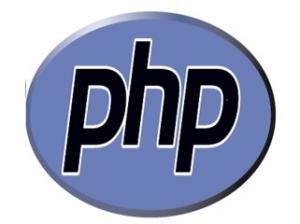
Introduction: The current() function in PHP returns the current element (unit) in the array. Each array has an internal pointer pointing to it. Its "current" unit initially points to the first unit inserted into the array. If we execute current once, the internal pointer will point to the next unit, and we can use current to get the value of the current unit in the array. This article collects several articles on the usage of PHP's array operation function current(). I hope it will be helpful to everyone's understanding of array operations. 1.php array function current(...
2. 10 recommended articles about array operations

Introduction: The current() function in PHP returns the current element (unit) in the array. Each array has an internal pointer pointing to its "current" The unit initially points to the first unit inserted into the array. If we execute current once, the internal pointer will point to the next unit. We can use current to get the value of the current unit in the array. This article collects several articles about. The usage of php array function current(), I hope it will be helpful to everyone's understanding of array operations. 1.php array function current(...
3. mysql_fetch_field function example. Usage summary

Introduction: mysql_init initializes the database link – gets a link mysql_real_connect connects to the database server and executes mysql_query query – The query statement is a string that retrieves each row separately. mysql_store_result – the result is stored in the link. It is a one-time query. From the result set, the header information is obtained – mysql_fetch_fields – the header information is stored in the memory space parsing table pointed to by the MYSQL_FIELD type pointer. Header –mysql_...
4. Summary of usage of mysql_fetch_field() function
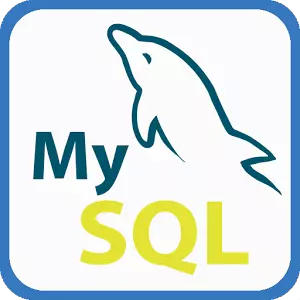
Introduction: mysql_init initializes the database link – gets a link mysql_real_connect connects to the database server and executes mysql_query query – the query statement is a string and retrieves each row separately mysql_store_result – the result is stored in the link and belongs once The query obtains the header information from the result set – mysql_fetch_fields – the header information is stored in the memory space pointed to by the MYSQL_FIELD type pointer and parses the header – mysql_...
##5. php Returns the elements in the array current() function usage summary
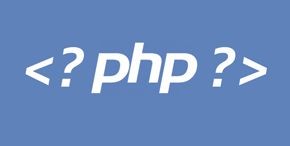
Introduction: The current() function in PHP returns the current element (unit) in the array. Each array has an internal pointer pointing to its "current" unit, which initially points to the element inserted into the array. For the first unit, if we execute current once, the internal pointer will point to the next unit, and we can use current to get the value of the current unit in the array. This article collects several articles on the usage of PHP's array operation function current(). I hope it will be helpful to everyone's understanding of array operations.
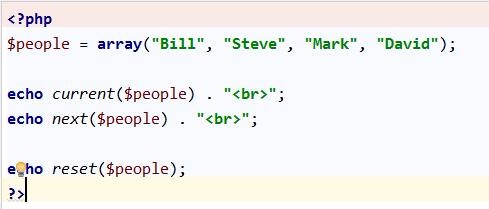
Introduction: The current() function in PHP returns the current element (unit, which is the first element of the array) in the array. The next() function points the internal pointer to the next element in the array. element and output the value of the element. The reset() function points the internal pointer to the first element in the array and outputs the value of the element. This article mainly introduces the usage of current, next and reset functions in PHP. The example form details the specific usage of the functions current, next and reset for array operations in PHP. It has certain reference value for in-depth understanding of the usage of arrays. I hope it will be helpful to everyone's understanding of arrays
7. Detailed explanation of usage examples of php end() function and current() function
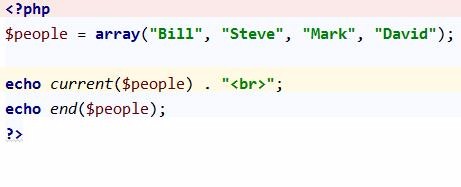
# #Introduction: The end() function in php points the internal pointer of the array to the last element and returns the value of the element, while the current() function returns the current element (unit) in the array, which is the first element of the array. One of the two functions returns the first element of the array, and the other returns the last element of the array. Let’s take a look at the usage of these two functions.
8. php Array Definition and usage of function current()
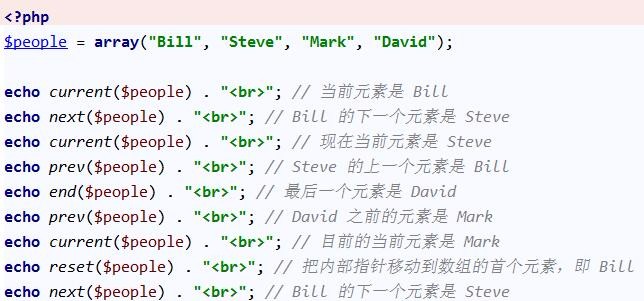
php framework and ajax implementation. Summary of drop-down menu functions
##Introduction: In Web development, drop-down menus are displayed in It consists of the main menu bar at the top of the window and submenus below each menu bar. Usually, only the menu bar is displayed in the window, and when the mouse pointer points to the menu bar, the submenus of the menu bar are displayed. The menu is displayed 10.
10.
Introduction: jQuery is a javascript library that is very convenient to use and very powerful. Normally, only the menu bar is displayed in the window, and when the mouse pointer points to the menu bar, the menu bar's submenus are displayed. When the mouse pointer leaves the menu, the submenu is hidden and only the main menu bar is displayed.
 [Related Q&A recommendations]:
[Related Q&A recommendations]:
javascript - Ask a question about JS function.apply()
Memory issues pointed to by pointers in c++
Arithmetic issues with pointers in C language
java - c/c++ pointers point to arrays and data Is there any ambiguity in type judgment?
c++ - What happens after calling the free() function on a piece of memory?
The above is the detailed content of 10 recommended articles about pointers. For more information, please follow other related articles on the PHP Chinese website!

Hot AI Tools

Undresser.AI Undress
AI-powered app for creating realistic nude photos

AI Clothes Remover
Online AI tool for removing clothes from photos.

Undress AI Tool
Undress images for free

Clothoff.io
AI clothes remover

Video Face Swap
Swap faces in any video effortlessly with our completely free AI face swap tool!

Hot Article

Hot Tools

Notepad++7.3.1
Easy-to-use and free code editor

SublimeText3 Chinese version
Chinese version, very easy to use

Zend Studio 13.0.1
Powerful PHP integrated development environment

Dreamweaver CS6
Visual web development tools

SublimeText3 Mac version
God-level code editing software (SublimeText3)

Hot Topics
 1664
1664
 14
14
 1423
1423
 52
52
 1318
1318
 25
25
 1269
1269
 29
29
 1248
1248
 24
24
 PHP and Python: Comparing Two Popular Programming Languages
Apr 14, 2025 am 12:13 AM
PHP and Python: Comparing Two Popular Programming Languages
Apr 14, 2025 am 12:13 AM
PHP and Python each have their own advantages, and choose according to project requirements. 1.PHP is suitable for web development, especially for rapid development and maintenance of websites. 2. Python is suitable for data science, machine learning and artificial intelligence, with concise syntax and suitable for beginners.
 Explain secure password hashing in PHP (e.g., password_hash, password_verify). Why not use MD5 or SHA1?
Apr 17, 2025 am 12:06 AM
Explain secure password hashing in PHP (e.g., password_hash, password_verify). Why not use MD5 or SHA1?
Apr 17, 2025 am 12:06 AM
In PHP, password_hash and password_verify functions should be used to implement secure password hashing, and MD5 or SHA1 should not be used. 1) password_hash generates a hash containing salt values to enhance security. 2) Password_verify verify password and ensure security by comparing hash values. 3) MD5 and SHA1 are vulnerable and lack salt values, and are not suitable for modern password security.
 PHP in Action: Real-World Examples and Applications
Apr 14, 2025 am 12:19 AM
PHP in Action: Real-World Examples and Applications
Apr 14, 2025 am 12:19 AM
PHP is widely used in e-commerce, content management systems and API development. 1) E-commerce: used for shopping cart function and payment processing. 2) Content management system: used for dynamic content generation and user management. 3) API development: used for RESTful API development and API security. Through performance optimization and best practices, the efficiency and maintainability of PHP applications are improved.
 PHP: A Key Language for Web Development
Apr 13, 2025 am 12:08 AM
PHP: A Key Language for Web Development
Apr 13, 2025 am 12:08 AM
PHP is a scripting language widely used on the server side, especially suitable for web development. 1.PHP can embed HTML, process HTTP requests and responses, and supports a variety of databases. 2.PHP is used to generate dynamic web content, process form data, access databases, etc., with strong community support and open source resources. 3. PHP is an interpreted language, and the execution process includes lexical analysis, grammatical analysis, compilation and execution. 4.PHP can be combined with MySQL for advanced applications such as user registration systems. 5. When debugging PHP, you can use functions such as error_reporting() and var_dump(). 6. Optimize PHP code to use caching mechanisms, optimize database queries and use built-in functions. 7
 How does PHP type hinting work, including scalar types, return types, union types, and nullable types?
Apr 17, 2025 am 12:25 AM
How does PHP type hinting work, including scalar types, return types, union types, and nullable types?
Apr 17, 2025 am 12:25 AM
PHP type prompts to improve code quality and readability. 1) Scalar type tips: Since PHP7.0, basic data types are allowed to be specified in function parameters, such as int, float, etc. 2) Return type prompt: Ensure the consistency of the function return value type. 3) Union type prompt: Since PHP8.0, multiple types are allowed to be specified in function parameters or return values. 4) Nullable type prompt: Allows to include null values and handle functions that may return null values.
 The Enduring Relevance of PHP: Is It Still Alive?
Apr 14, 2025 am 12:12 AM
The Enduring Relevance of PHP: Is It Still Alive?
Apr 14, 2025 am 12:12 AM
PHP is still dynamic and still occupies an important position in the field of modern programming. 1) PHP's simplicity and powerful community support make it widely used in web development; 2) Its flexibility and stability make it outstanding in handling web forms, database operations and file processing; 3) PHP is constantly evolving and optimizing, suitable for beginners and experienced developers.
 PHP vs. Python: Understanding the Differences
Apr 11, 2025 am 12:15 AM
PHP vs. Python: Understanding the Differences
Apr 11, 2025 am 12:15 AM
PHP and Python each have their own advantages, and the choice should be based on project requirements. 1.PHP is suitable for web development, with simple syntax and high execution efficiency. 2. Python is suitable for data science and machine learning, with concise syntax and rich libraries.
 PHP and Python: Code Examples and Comparison
Apr 15, 2025 am 12:07 AM
PHP and Python: Code Examples and Comparison
Apr 15, 2025 am 12:07 AM
PHP and Python have their own advantages and disadvantages, and the choice depends on project needs and personal preferences. 1.PHP is suitable for rapid development and maintenance of large-scale web applications. 2. Python dominates the field of data science and machine learning.




